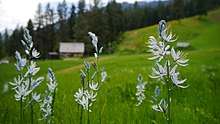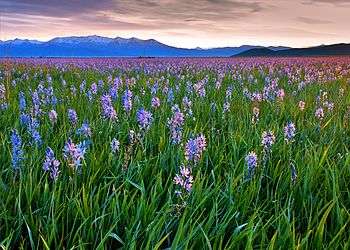Camassia quamash
Camassia quamash, commonly known as camas, small camas,[1] common camas,[2] common camash[3] or quamash, is a perennial herb. It is native to western North America in large areas of southern Canada and the northwestern United States, from British Columbia and Alberta to California and east from Washington state to Montana and Wyoming.
| Common Camas | |
|---|---|
_Greene.jpg) | |
| Camassia quamash (Pursh) Greene | |
| Scientific classification | |
| Kingdom: | Plantae |
| Clade: | Tracheophytes |
| Clade: | Angiosperms |
| Clade: | Monocots |
| Order: | Asparagales |
| Family: | Asparagaceae |
| Subfamily: | Agavoideae |
| Genus: | Camassia |
| Species: | C. quamash |
| Binomial name | |
| Camassia quamash (Pursh) Greene | |
Description
Growth pattern
It is a perennial herbaceous monocot with leaves emerging from a persistent bulb in a basal rosette.
Leaves, stems, and roots
The stems have a length between 30 and 90 centimetres (12 and 35 in). The leaves are basal and have a grass-like appearance.
Taxonomy
There are eight subspecies;[5]
- Camassia quamash subsp. azurea – small camas
- Camassia quamash subsp. breviflora – small camas
- Camassia quamash subsp. intermedia – small camas
- Camassia quamash subsp. linearis – small camas
- Camassia quamash subsp. maxima – small camas
- Camassia quamash subsp. quamash – common camas
- Camassia quamash subsp. utahensis – Utah small camas
- Camassia quamash subsp. walpolei – Walpole's small camas
Synonyms
The superseded name for Camassia quamash supsp. quamash, Camassia esculenta (Nutt.) Lindl.,[6] should not be confused with the superseded name Camassia esculenta (Ker Gawl.) B.L.Rob., (nom. illeg.) for Camassia scilloides.[7]
Etymology
The genus name comes from the Nez Perce Indian name for this plant, and means "sweet".[4] Qém'es, a term for the plant's bulb, which was gathered and used as a food source by tribes in the Pacific Northwest, and were an important food source for the Lewis and Clark Expedition (1804–1806).[4] The bulbs were harvested and pit-roasted or boiled by women of the Nez Perce, Cree, and Blackfoot tribes.
Distribution and habitat
Though the once-immense spreads of camas lands have diminished because of modern developments and agriculture, numerous camas prairies and marshes may still be seen today. In the Great Basin, expanded settlement by whites accompanied by turning cattle and hogs onto camas prairies greatly diminished food available to native tribes and increased tension between Native Americans and settlers and travelers.[8] Both the Bannock and Nez Perce Wars began after Nez Perce became incensed at the failure of the US government to uphold treaties, and at settlers who plowed up their camas prairies, which they depended on for subsistence.[9][10][11][12]
Cultivation
This bulbflower naturalizes well in gardens. The bulb grows best in well-drained soil high in humus. It will grow in lightly shaded forest areas and on rocky outcrops as well as in open meadows or prairies. Additionally it is found growing alongside streams and rivers. The plants may be divided in autumn after the leaves have withered. Additionally the plant spreads by seed rather than by runners.
Uses
Camas is not just an edible plant, it is also grown as an ornamental plant. Even in the wild, large numbers of camas can color an entire meadow blue-violet.
Food use

The bulbs of Camassia species are edible and nutritious when roasted or boiled,[13] but should not be confused with the toxic white-flowered meadow death-camas (which is not in Camassia, but part of the genus Toxicoscordion, which grows in the same areas); the bulbs are difficult to distinguish.[14][15]
Camas has been a food source for many native peoples in the western United States and Canada. After being harvested in the autumn, once the flowers have withered, the bulbs are pit-roasted or boiled. The latter produced a syrup.[16] A pit-cooked camas bulb looks and tastes something like baked sweet potato, but sweeter, and with more crystalline fibers due to the presence of inulin in the bulbs—an oligosaccharide responsible for the copious flatulence caused by excessive consumption or consumption of undercooked bulbs. Bulbs can also be dried and pounded into flour, which can be used for baking or as a thickener.[17][18] Native American tribes who ate camas include the Nez Perce, Cree, Coast Salish, Lummi, and Blackfoot tribes, among many others. Camas bulbs contributed to the survival of members of the expedition of Lewis and Clark (1804–06).
Camas bulbs (and bannock made from them) are listed in the Ark of Taste.[19][20]
Gallery
- Camassia quamash subsp. maxima, Skagit County, Washington
 Camas meadow near Bovill, Idaho
Camas meadow near Bovill, Idaho- C. quamash seeds
 Camassia quamash ssp. quamash
Camassia quamash ssp. quamash- Indian Camas (Camassia quamash) Bald Hill Park, Corvallis, Oregon
 Camassia quamash at Leavenworth Ski Hill, Chelan County Washington
Camassia quamash at Leavenworth Ski Hill, Chelan County Washington Sunrise at Camas Prairie Centennial Park
Sunrise at Camas Prairie Centennial Park
References
- "Camassia quamash". Natural Resources Conservation Service PLANTS Database. USDA. Retrieved 1 February 2013.
- Kozloff, Eugene N. (2005). Plants of Western Oregon, Washington & British Columbia. Portland, Oregon: Timber Press. p. 410. ISBN 978-0-88192-724-5.
- "BSBI List 2007". Botanical Society of Britain and Ireland. Archived from the original (xls) on 23 October 2014. Retrieved 2014-10-17.
- Karen Wiese, Sierra Nevada Wildflowers, p.22
- World Checklist of Selected Plant Families
- World Checklist of Selected Plant Families: Camassia esculenta (Nutt.) Lindl.
- World Checklist of Selected Plant Families: Camassia esculenta (Ker Gawl.) B.L.Rob.
- The Shoshoni Frontier and the Bear River Massacre, Brigham D. Madsen, forward by Charles S. Peterson, University of Utah Press (1985, paperback 1995), trade paperback, 286 pages, ISBN 0-87480-494-9
- Clute, Willard Nelson (1907). The American botanist, devoted to economic and ecological botany, Volumes 11-15. W.N. Clute & co. p. 98.
- Mathews, Daniel (1999). Cascade-Olympic Natural History: a trailside reference. Raven Editions. p. 168. ISBN 978-0-9620782-1-7.
- Native American History: The Bannock War Retrieved 1 March 2008.
- Brimlow, George Francis. Harney County and Its Range Land, 1951, Binfords & Mort, Portland, Oregon, p. 102ff.
- Lyons, C. P. (1956). Trees, Shrubs and Flowers to Know in Washington (1st ed.). Canada: J. M. Dent & Sons. p. 196.
- Pojar, Jim; MacKinnon, Andy. Plants of the Pacific Northwest Coast. Lone Pine Publishing, 1994, pp. 108-109, ISBN 978-1-55105-040-9
- Karen Wiese, Sierra Nevada Wildflowers, p.170
- Whitney, Stephen (1985). Western Forests (The Audubon Society Nature Guides). New York: Knopf. p. 595. ISBN 0-394-73127-1.
- Pieroni, Andrea (2005). Prance, Ghillean; Nesbitt, Mark (eds.). The Cultural History of Plants. Routledge. p. 34. ISBN 0415927463.
- Doherty, Craig A.;Doherty, Katherine M. Plateau Indians, Infobase Publishing, 2008, p.42, ISBN 978-0-8160-5971-3
- Camas Bulbs, Ark of Taste, Slow Food Foundation for Biodiversity
- Quamash Bannock, Ark of Taste, Slow Food Foundation for Biodiversity
External links
- Flora of North America: Camassia quamash
- Plants For A Future: Camassia quamash
- Michigan State University Extension: Camassia quamash
| Wikimedia Commons has media related to Camassia quamash. |
| Wikispecies has information related to Camassia quamash |